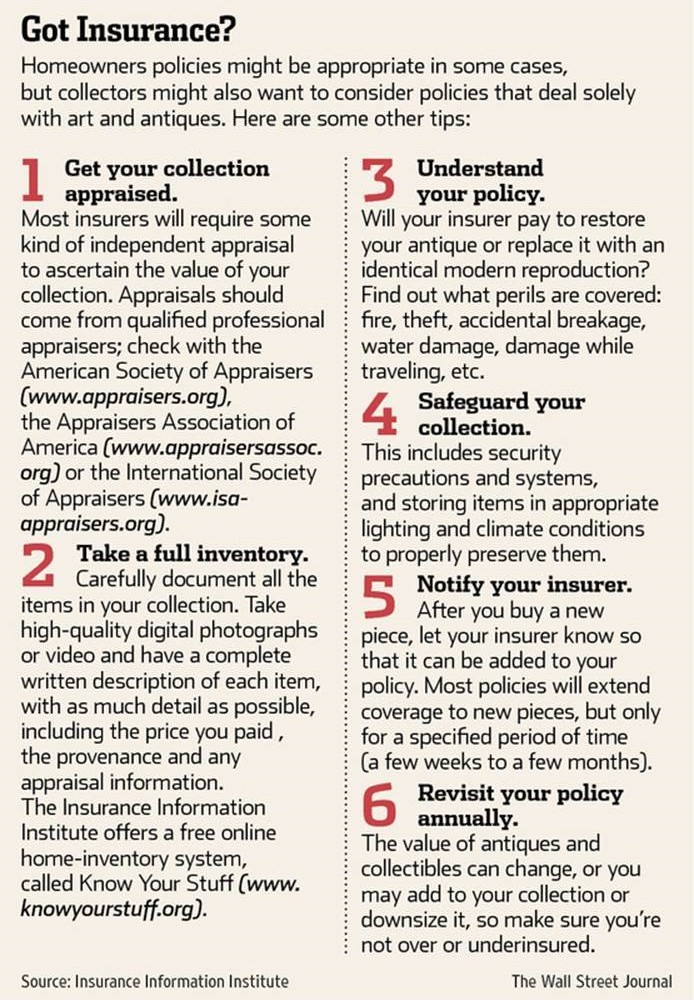WALL STREET JOURNAL REPORT: WEALTH MANAGEMENT
April 18, 2013, 2:17 p.m. ET
Wall-to-Wall Insurance
Superstorm Sandy may create a wave of art collectors seeking additional, specialized coverage
By DANIEL GRANT
The Coverage
Most homeowners policies cover the contents of one’s home, which may include art, antiques, jewelry, silver and other valuables. Homeowners insurance will cover theft and damage to artwork, but there may be a limit for how much the insurer will pay for a single item—for instance, $10,000 for a work of art—and there is often a deductible.
Homeowners policies cover certain types of perils, such as fire and falling tree limbs, but not earthquakes or floods. Coverage for those events needs to be purchased separately.
Many homeowners policies won’t cover breakage (a vase or sculpture falls on the floor) or damage during transit (a painting being moved from the primary residence to a summer cottage, for instance).
Fine-arts insurance policies, on the other hand, have no deductibles and pay the full appraised value of a stolen or damaged object without regard to how the piece was damaged; they generally cover all major contingencies, such as floods, earthquakes, tornadoes and even acts of terrorism, as well as damage occurring while the piece is being moved.
These policies typically offer immediate protection to newly acquired items, such as a statue purchased on vacation, as long as the acquisition is reported to the insurance carrier within 90 days. (The policyholder’s premium may be increased, prorated to the date of the purchase.) That coverage protects the buyer if the object is damaged in transit.
There are some exclusions for fine-arts policies, involving wear and tear (a sculpture located outdoors may be damaged by the elements or acid rain), gradual deterioration (paint chips fall off older canvases), so-called inherent vices (artwork that wasn’t made with longevity in mind), war, nuclear explosions and biological contamination.
The Cost
The cost of a fine-arts policy varies widely based on what is being insured and where the objects are located. Yearly premiums for a $1 million collection average about $700 to $2,200 in many areas, but they might be 1% to 8% higher in cities seen as potential terrorist targets, says Lynn Marcin, senior vice president in charge of fine arts at Huntington T. Block Insurance Agency, which arranges customized fine-arts coverage for individual, commercial and institutional collections. Premiums in the most earthquake-prone and flood-prone areas, meanwhile, could be triple what they are elsewhere, she says.
But the lowest rates also imply that the owners have spent quite a bit of money to protect their collections in the first place. They’re only available if the insured has significant fire, theft and climate-control systems in place, says Joe Dunn, president and chief executive officer of Huntington T. Block. These include central station alarms to alert police when a break-in is occurring, a plan to remove valuables to a nearby fine-art storage facility or a specially constructed safe room in one’s home during a hurricane or tornado, and climate controls that ensure levels of heat, cooling and humidity appropriate to works of art.
The costs don’t end with the premiums, however. Insurance coverage of particular artwork is based on “agreed values,” which generally are determined by appraisers.
Fine-art insurers such as AIG, Chubb and Fireman’s Fund keep a list of appraisers they have vetted. Prospective policyholders aren’t required to use appraisers on the company lists, but the insurance carrier will determine if it accepts the work of someone else.
Ms. Spanierman, the art consultant, says she determines beforehand with a collector whether to charge by the hour ($250), by the day ($1,500) or a negotiable flat fee. The more items or more complicated the item, the higher the cost.
Since artwork often increases in value over time, it is usually recommended that fine-arts policyholders get updated appraisals every three to five years, and premiums may be adjusted accordingly.
Mr. Grant is a writer in Amherst, Mass. He can be reached at reports@wsj.com.
